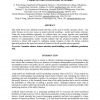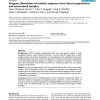DSS
2008
14 years 15 days ago
2008
This study shows how artificial neural networks can be used to model consumer choice. Our study focuses on two key issues in neural network modeling
CACM
2008
14 years 16 days ago
2008
In this article, we study the problem of distributed selection from a theoretical point of view. Given a general connected graph of diameter D consisting of n nodes in which each ...
BMCBI
2008
2008
WSPMaker: a web tool for calculating selection pressure in proteins and domains using window-sliding
14 years 17 days ago
Background: In the study of adaptive evolution, it is important to detect the protein coding sites where natural selection is acting. In general, the ratio of the rate of non-syno...
BMCBI
2008
14 years 17 days ago
2008
Background: FREGENE simulates sequence-level data over large genomic regions in large populations. Because, unlike coalescent simulators, it works forwards through time, it allows...
BMCBI
2008
14 years 17 days ago
2008
Background: Two problems complicate the study of selection in viral genomes: Firstly, the presence of genes in overlapping reading frames implies that selection in one reading fra...
BMCBI
2010
14 years 17 days ago
2010
Background: Feature selection techniques are critical to the analysis of high dimensional datasets. This is especially true in gene selection from microarray data which are common...
BMCBI
2010
14 years 17 days ago
2010
Background: Natural selection eliminates detrimental and favors advantageous phenotypes. This process leaves characteristic signatures in underlying genomic segments that can be r...
ALIFE
2008
14 years 17 days ago
2008
, reproductive value, soft selectionAbstract Structural complexity characterizes our representations of dissipative structures. As a mechanistic concept, when referred to natural s...
WSC
2004
14 years 1 months ago
2004
Simulation plays a vital role in identifying the best system design from among a set of competing designs. To improve simulation efficiency, ranking and selection techniques are o...
ATAL
2008
Springer
14 years 2 months ago
2008
Springer
The design of deterministic and fair mechanisms for selection among a set of self-motivated agents based solely on these agents' input is a major challenge in multiagent syst...




